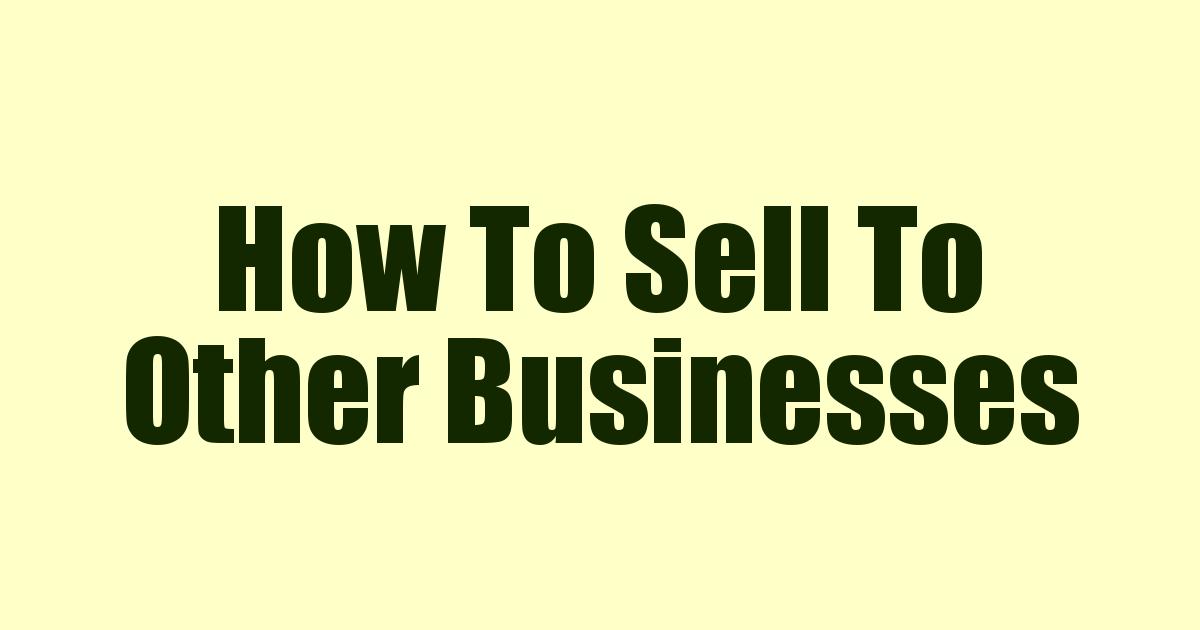 Business to marketing seems like a foreign language to many people who are trying it for the first time. The consumer markets seems so much plainer and easier, after all, we're dealing with every day people. With businesses we feel we are dealing with some mysterious entity or some divine VIP, a thing whose persona is foreign to everything we knew in the every day human consciousness.
Business to marketing seems like a foreign language to many people who are trying it for the first time. The consumer markets seems so much plainer and easier, after all, we're dealing with every day people. With businesses we feel we are dealing with some mysterious entity or some divine VIP, a thing whose persona is foreign to everything we knew in the every day human consciousness.
The reality that most people miss, and it's a well-kept secret, businesses are people. They are decision makers, executives, highly paid company officers, and even midgrade managers. At the end of the day though, they are people, selling to other businesses is no different than selling to people, except that you have to consider the kind of person you're selling to. Much of this involves trying to get into a person's head. What does a business owner or manager need and/or want? What things will improve their lives, and more importantly, the operations of their business? Answering these questions is the first key to selling to other businesses.
1: Identify Your VIP
The first step in creating a strong pitch for your product and service is considering your VIP, there may be more than one to consider depending on how the decisions are made. You have to know who you're selling to and then consider how your business can benefit them personally. As we discussed, you're dealing with real people, and they taking their own needs and desires into consideration as well as their roles in serving the greater needs of the company. Is your contact a buyer, a manger, or a business owner?
Depending on who you're speaking to, you'll want to come with ideas and features about what you have to offer and how it makes their lives easy as well benefiting their employer.
2: Don't Just Sell, Give Them Something They Can Use
Whoever your VIP may be, you can expect that someone has found them too, and they probably get multiple pitches a day for what you have to offer. A simple letter with a sales pitch is no longer enough to draw people in anymore. Because of this, you want to attach your sales pitch to something they can use. Many companies do this by offering white papers. White papers may be written as guides on important industry topics and trends, and may even highlight problems the industry is facing. This can be accompanied by a pitch explaining how you offer a solution. Either way the white papers are free and useful, so there's no harm in reading.
Writing effective white papers isn't easy, but it can be done.
3: Start With Value Over Price
When you're making a pitch to any business, you may find yourselves in the middle of a bidding war. Too many entrepreneurs focus in only on their prices as a way to put their best foot forward. While pricing certainly is important, it's far more vital to highlight the value your product has to offer. What can your product do that others can't. Can it save the company time or money even while requiring an investment? Can it make life easier for managers or help improve employee morale and productivity?
When you're making your bid don't advertise that you are cheap. If anything this will raise red flags if it's all you have to offer.
4: Highlight The Business Benefits
Whether it's in consumer to consumer or business to business marketing, even professionals have made this terrible mistake in copy-writing. Never just tell someone about the features of what you have to offer. Features are boring and no one wants to hear you list them all day long. They want to know how what you have to offer is going to solve a common problem. Just don't tell them “My computers have a lot of RAM” but instead consider, “Are you tired of losing valuable company time and money waiting for your computers to load? With our CPUs high RAM capability your upload, download, and processing speeds will be through the roof. You'll save time, money, and your business will be moving at lightning speed when processing your data!”
Benefits are everything. Nobody wants to know what you can do, everyone wants to know what you can do “For me”
5: Make it Easy To Act
Your call to action (CTA) is the grand finale of any pitch you write. It needs be dazzling and out of the park, but more importantly, it needs to be easy to act upon. Links in emails should be large, thought not obnoxious, and easy to see and click on, and MUST NOT BE BROKEN OR INACCURATE. Contact info should be prominent, accurate, and very visible. Like it or not, nobody likes a hassle. If your final pitch is hard to act on, even a little, or your lead finds it hard to get in touch you may lose your sale to someone else out of sheer convenience.
6: Gather Leads
This probably should have been the first step, but you need to gather solid prospective leads to sell to. It means nothing if you have the greatest product in the world and killer sales pitch to back it up, and no relevant people to sell it to. Gathering leads can be tricky, but made much easier by programs like Macroleads that help you organize, streamline, and even somewhat automate the process.


